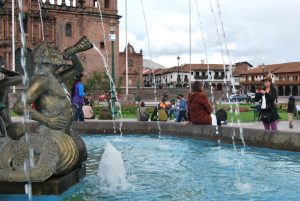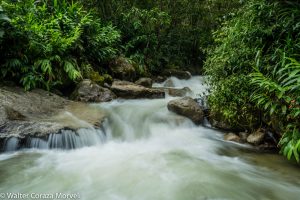Water and Incas in Cuzco

In 1992 the United Nations declared March 22 of every year to be World Water Day. Its purpose is to raise awareness around the world of the importance of water and its supply for our lives and for the ecosystems win which we live. It also as created in order to promote, year after year, UN initiatives and proposals regarding water, in conjunction with national and local governmental entities.
The key word today is “sustainable” and in Cuzco’s Regocijo Plaza a display has been set up to teach people about the challenges and value of water in its region. Indeed Cuzco faces challenges with climate change as its tropical glaciers retreat taking with themselves the traditional source of drinking water for the city.

However, the City still guards its Inca past when the city was, to a major degree, a massive temple to water. The core of the Imperial City stood between two rivers, the Saphi and the Tullumayu. Even today they flow, now in underground canals for most of their length, though their coming together to form the Watanay River is marked by a fountain widely called the Paccha.
Within the city there are fountains where water springs suddenly into view, sometimes as trickles and sometimes as a large flow. Water flowing whether in fountains and canals, or from sky to ground and then to the lakes and sea was and is important to the Inca and their descendants.
People tell outsiders of the sacred trilogy of sun, moon, and stars, as well as that of condor, puma, and snake, but they often forget to mention how water formed and enabled the Inca world.

Inside the Cathedral, which was an Inca temple before the coming of the Catholics, on the back wall, right hand side if you are facing the wall, you will find the altar of the Lord of Unupunku. This is the Christ of the Water Gate. There was water here, and supposedly still is under the cathedral. The people of Cuzco traditionally make offerings to it while the image of Christ on the altar shows the Lord bearing a cross and rising from the water as if he were the representation of wet.
Indeed, there is more. Mannheim and Salas write that in Imperial Cuzco and until the nineteenth century there were two words in Quechua for water, unu and yaku. The first, unu, according to Mannheim, refers to water while the second refers to water in movement. As a result, this is the Lord of water, while the canals, rivers, streams, and the many springs, or puquios, still given reverence within Cuzco, refer to water flowing. Water in motion was said, according to Mannheim and Salas, to have agency, will power. It acts and all humans can do is give it direction. Mannheim and Salas note “An irrigation canal, then, could not “carry” water; rather the canal “guided” or “led” water. The difference is substantial.

It speaks to an understanding of being and leadership as engaging with other agencies and giving them direction such that the fields get water, the crops grow, children are born, and grow up. Life continues.
Indeed, another image of power is the shine of light reflecting off a body of water. This gleam is enshrined in the name of a nearby street Tecsicocha and in the image of Illapa, the lightning lord, who was honored in San Blas and in the Cathedral. Even today, he is associated with rain, perhaps not as the bringer of it in the sense of carrying it, but in the sense of channeling it and zigzagging across the sky in light when the rain comes.
On this World Water Day, to better understand sustainability, it is also useful to grasp how the Incas created their Empire with water.
Reference:
Bruce Mannheim and Guillermo Salas Careño, “Wak’as: Entification of the Andean Sacred” in Tamara L. Bray, ed., The Archeology of Wak’as: Exploration of the Sacred in the Pre-Columbian Andes (University Press of Colorado, 2015), p. 48.




